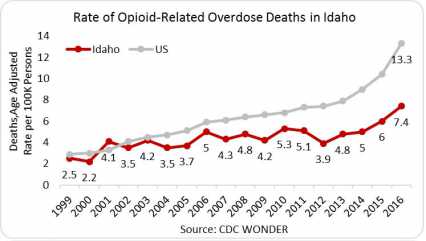Idaho can’t say we’re winning the war against accidental opioid deaths, but we’re fighting a good fight. As you can see, the numbers are climbing. If you want a very in depth and excellent analysis of the situation, read this from the Idaho Department of Health and Welfare. I will focus on two points.
Idaho has a higher rate of prescribing opioids than the national average. We as a state have a long way to go in educating prescribers on best practices to avoid overdose deaths. We have made education available for prescribers through the Board of Medicine, the Board of Pharmacy, the DHW; many resources are available. Indeed, there’s education but also sanctions. The legislature has made it possible for the two independent Boards (Pharmacy, who keep the data on prescribing and Medicine, who has the power to sanction) to communicate about prescribing practices. The BoP maintains an accurate data base of controlled substance prescriptions that can be accessed 24/7 by prescribers and pharmacists. The legislature has made this access easier, but not mandatory. Use of the data base has steadily increased. Still, the number of narcotic prescriptions continues to rise.
Of interest, the highest rates of prescribing narcotics are in our rural and frontier counties. I don’t think it hurts more to live on the frontier, but the association between chronic pain and poverty and rural or frontier life is real. Caring for chronic pain is a demanding task and resources can be limited for a rural practitioner. Still, with this information, with proper education, incentives and support, I believe this can improve. We shall see.
But we can only see how we are doing if we have good information; that gets to the second point. Idaho is quite likely underreporting accidental overdose deaths from prescription narcotics. Of all reported overdose deaths in Idaho only 2/3rds had a drug listed as a cause on the death certificate. Overdose deaths without a drug listed as the cause don’t get counted as narcotic overdoses. Some weren’t; some were. We won’t know unless we investigate and report.
Overdose deaths are investigated and reported by the county coroner. Idaho has 44 county coroners and I can tell you, they all don’t have a CSI lab. Heck, many don’t even have an official vehicle; I didn’t. You’d think the counties most likely to have lax reporting would be the rural ones, and indeed some are. In Ada County about 90% of the overdose deaths designate a drug; but Bonneville County reported just 40%. Canyon County only hit 35%. Maybe we have a faulty system. Studies of death investigations nationwide have shown that states that have a county coroner system (as opposed to a Medical Examiner system) are much lower at determining which drug caused the overdose death.
Ever since I was the Latah County Coroner for 15 years I have wondered about the wisdom of the county coroner system for the state of Idaho.
I write this as a practicing physician who prescribes controlled substances and as a former County Coroner. I appeal to my physician colleagues: we can do a better job prescribing narcotics, treating pain, preserving the health of our communities.
To all the County Coroners, ask yourselves, are you happy with the system you have for investigating deaths? Are you doing a good job? Are there ways this could be done better? Just because it’s the law we have now doesn’t mean we can’t improve the system. Think about it.

